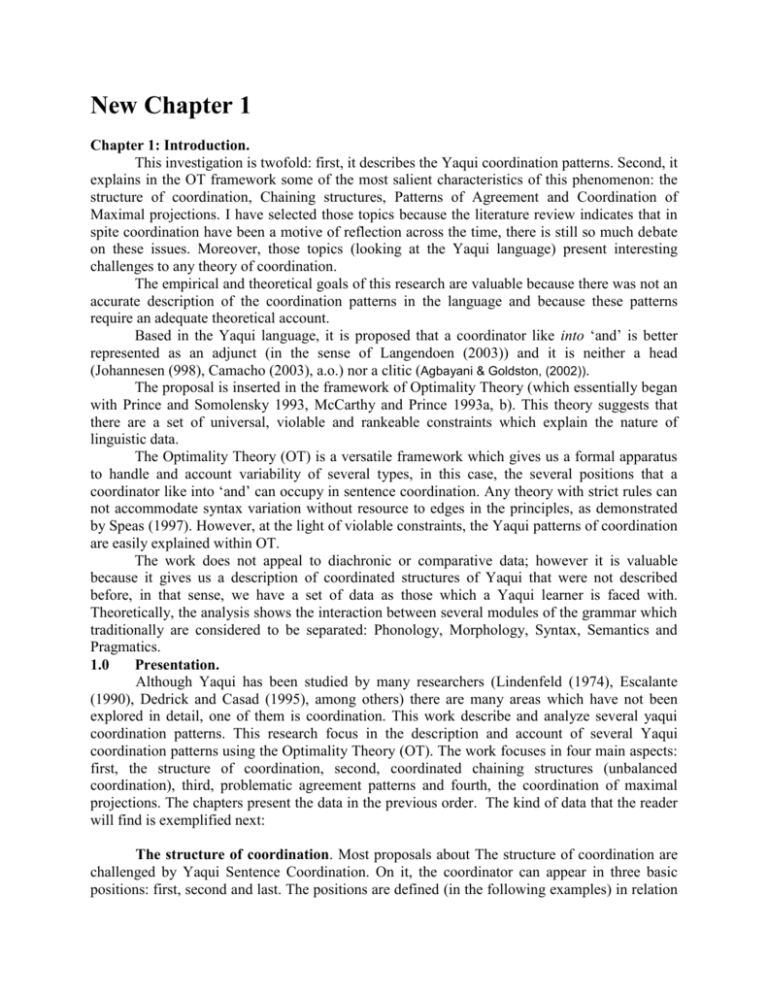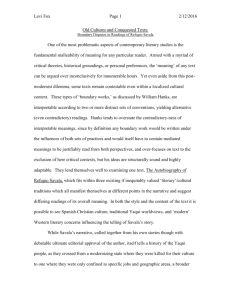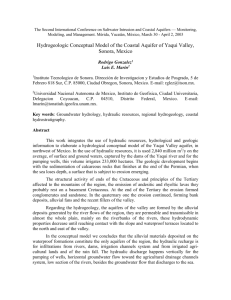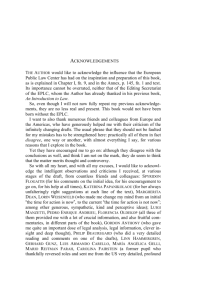New Chapter 1 - University of Arizona
advertisement

New Chapter 1 Chapter 1: Introduction. This investigation is twofold: first, it describes the Yaqui coordination patterns. Second, it explains in the OT framework some of the most salient characteristics of this phenomenon: the structure of coordination, Chaining structures, Patterns of Agreement and Coordination of Maximal projections. I have selected those topics because the literature review indicates that in spite coordination have been a motive of reflection across the time, there is still so much debate on these issues. Moreover, those topics (looking at the Yaqui language) present interesting challenges to any theory of coordination. The empirical and theoretical goals of this research are valuable because there was not an accurate description of the coordination patterns in the language and because these patterns require an adequate theoretical account. Based in the Yaqui language, it is proposed that a coordinator like into ‘and’ is better represented as an adjunct (in the sense of Langendoen (2003)) and it is neither a head (Johannesen (998), Camacho (2003), a.o.) nor a clitic (Agbayani & Goldston, (2002)). The proposal is inserted in the framework of Optimality Theory (which essentially began with Prince and Somolensky 1993, McCarthy and Prince 1993a, b). This theory suggests that there are a set of universal, violable and rankeable constraints which explain the nature of linguistic data. The Optimality Theory (OT) is a versatile framework which gives us a formal apparatus to handle and account variability of several types, in this case, the several positions that a coordinator like into ‘and’ can occupy in sentence coordination. Any theory with strict rules can not accommodate syntax variation without resource to edges in the principles, as demonstrated by Speas (1997). However, at the light of violable constraints, the Yaqui patterns of coordination are easily explained within OT. The work does not appeal to diachronic or comparative data; however it is valuable because it gives us a description of coordinated structures of Yaqui that were not described before, in that sense, we have a set of data as those which a Yaqui learner is faced with. Theoretically, the analysis shows the interaction between several modules of the grammar which traditionally are considered to be separated: Phonology, Morphology, Syntax, Semantics and Pragmatics. 1.0 Presentation. Although Yaqui has been studied by many researchers (Lindenfeld (1974), Escalante (1990), Dedrick and Casad (1995), among others) there are many areas which have not been explored in detail, one of them is coordination. This work describe and analyze several yaqui coordination patterns. This research focus in the description and account of several Yaqui coordination patterns using the Optimality Theory (OT). The work focuses in four main aspects: first, the structure of coordination, second, coordinated chaining structures (unbalanced coordination), third, problematic agreement patterns and fourth, the coordination of maximal projections. The chapters present the data in the previous order. The kind of data that the reader will find is exemplified next: The structure of coordination. Most proposals about The structure of coordination are challenged by Yaqui Sentence Coordination. On it, the coordinator can appear in three basic positions: first, second and last. The positions are defined (in the following examples) in relation to the second conjunct: first position means at the beginning of the second conjunct, second position means after an element of the second conjunct and last position means at last in the second conjunct or at last in a single sentence. They are exemplified as follows. First position: (1) Joan bwika into [peo into maria] ye’e John sings and [Peter and Mary] dance. Juan canta y [Pedro y María] bailan. ‘John sings and Peter and Mary Dance’ ‘Juan canta y Pedro y María bailan’ Second position: (2) Diana a tu’urek peo into au Diana it liked Peter and (a) Diana ello gustó Pedro y ‘Diana liked it and Peter bought it to her’ ‘A Diana le gustó y Pedro se lo compró’ Last position (Crumrine 1961:23)): (3) …Apo a’a tu’ute into a’a …He it clean and it ...‘Él lo limpia y lo ‘...And He cleans it up and He waters it.’ ‘…Y él lo limpia y lo riega.’ a jinuk her-to it bought. ella-a lo compró. ba’atuaintoko waters and and riega y Coordinated chaining structures. Yaqui have what has been called Unbalanced Coordination (Johannessen 1998) or Pseudosubordination (Yuasa and Sadock 2002). From a typological perspective, Givon (2001), Yaqui must be classified as a SOV-type chaining. The most salient syntactic feature of this type of clause chaining is the assignment of most finite grammatical marking only to the final clause. However, the entire chaining gets the tense indicated by the final clause. Next example shows the coordination of two chains (or two unbalanced coordinate sentences). We can see that the speaker split the actions in two events. The verbs that close the events are marked with the perfective –k. The coordinator into ‘and’ is possible inside both events. (4) ili small pequeña jamut yepsa-kai, jichikia-ta nu’u-kai, womanarrive-SUB broom-ACC take-SUB, mujer llegar-SUB escoba-AC tomar-SUB, jichik-taite-k sweep-INCOA-PERF barrer-INCOA-PERF (into) jichik-su-kai, sankoa-ta (and) sweep-TERM-SUB garbage-ACC (y) barrer-TERM-SUB basura-AC nau=toja-kai together=put-SUB junto=poner-SUB lejos mekka goota-k far away throw-PERF tirar-PERF ‘The young woman arrived, took the broom, began to sweep, (and) finished to sweep, put together the garbage and threw it away’ ‘La muchacha llegó, tomó la escoba, empezó a barrer (y) terminó de barrer, juntó la basura y la tiró lejos’. Problematic agreement patterns. In this work I analyze the following type of phenomenon. There are in yaqui some verbs which agree with the object. Under coordination a verb which requires a singular object takes two coordinated singular nouns, the plural verb can not be used in that case. This behavior indicates, according to Peterson (2004), that the nominal features of the conjoined items are not distributed. Therefore, it is worth to have a description and an analysis of these issues. (5) Alejandra maso-ta Alejandra deer-AC Alejandra venado-AC ‘Alejandra killed a deer’ ‘Alejandra mató un venado’ meak killed:SG OBJ mató:SG OBJ (6) *Alejandra maso-ta Alejandra deer-AC Alejandra venado-AC (‘Alejandra killed a deer’) (‘Alejandra mató un venado) suak killed:PL OBJ mató:PL OBJ (7) Alejandra maso-ta into kowi-ta Alejandra deer-AC and pig-AC Alejandra venado-AC y jabalí-AC ‘Alejandra killed a deer and a pig’ ‘Alejandra mató un venado y un jabalí’ meak killed:SG OBJ mató:SG OBJ (8) *Alejandra maso-ta into kowi-ta suak Alejandra deer-AC and pig-AC killed:PL OBJ Alejandra venado-AC y jabalí-AC mató:PL OBJ ‘Alejandra killed a deer and a pig’ ‘Alejandra mató un venado y un jabalí’ Coordination of maximal projections. Verb coordination shows several properties, some of them are the following: it is possible to have the coordination of two intransitive verbs, but it is not possible to have the coordination of two single transitive verbs. The second transitive verb always requires an object pronoun, suggesting that it is not possible to have the coordination of heads (Kayne 1994, Takano 2004). If this is true, several predictions must be tested in the language: (9) Andrea bwika into yeewe Andrea sings and plays Andrea canta y baila ‘Andrea sings and plays’ ‘Andrea canta y baila’ (10) Fabian caro-ta jinuk into Fabián car-ACC bought Fabián carro-AC compró ‘Fabian bougth and sold the car’ ‘Fabián compró y vendió el carro’ a and nenkak it sold (11) *Fabián caro-ta jinuk into Fabián car-ACC bought Fabián carro-AC compró (‘Fabian bougth and sold the car’) (‘Fabián compró y vendió el carro’) nenkak and sold Related facts to the previous ones, are the following: For example, the coordination structure must be able to explain the properties of Noun coordination, two of them are the following: it can be continuous or it can be discontinuous: (12) Paola senu na’aso-ta into senu mansana-ta bwaka Paola one orange-AC and one apple-AC ate Paola una naranja-AC y una manzana-AC comió ‘Paola ate one orange and one apple’ ‘Paola comió una naranja y una manzana’ (13) Paola senu na’aso-ta bwaka into senu Paola one orange-AC ate and one Paola una naranja-AC comió y una ‘Paola ate one orange and one apple’ ‘Paola comió una naranja y una manzana’ mansana-ta apple-AC manzana-AC Adjective coordination can be continuous or discontinuous too, but it requires a different case marker: (14) Paulina bemela-k into teebe-kbichak Paulina young-ACC and tall-ACC saw Paulina joven-AC y alto-AC vio ‘Paulina saw the young and (the) tall (one)’ ‘Paulina vio al joven y (al) alto’ (15) Paulina Paulina Paulina bemela-k young-ACC joven-AC bichak saw vio into and y teebe-k tall-ACC alto-AC ‘Paulina saw the young and the tall’ ‘Paulina vio al joven y al alto’ This work describes and identifies the conditions under which the above and other patters of Yaqui coordination emerge. It is given evidence that a coordinator must be treated as an adjunct. It is used some markedness, faitfulness and aligment OT constraints in order to account for the patterns attested in the language. 1.0.1 Empirical goals of this research. The main empirical goal of this work is to analyze and describe the relatively unknown patterns of yaqui coordination. As almost usual in every language and in every topic that linguists explore, Yaqui presents very particular patterns of coordination that a good theory of language should be able to predict and explain. As we can see trough this research, there are so challenging patterns that do not fix to traditional accounts. In order to achieve this goal, I investigate several types of constructions: sentence coordination, verbal and nominal coordination as well as other coordinate structures such as relative clauses, adjective constructions, among others. The central idea is to characterize the coordination patterns of the language. 1.0.1 Theoretical goals of this research. The aim of this work is to analyze Yaqui coordination within the framework of Optimality Theory (OT). This theory of grammar has been (mostly) used to explain phonological and morphological properties of languages, but few work has been devoted to the explanation of their syntactic properties. So, this dissertation pretend to be a contribution to OT literature. The patterns of Yaqui coordination has neither been described nor accounted for. The only work which describe some aspects about coordinated structures is that of Dedrick and Casad (1995), but many facts have been left untouched. Therefore, it is usefull to look at and explain them. In order to do the analysis, I use several constraints well motivated in the literature such as alignment constraints (Choi, 2001), Markedness constraints and faithfulness constraints. The theoretical contribution of this work relates to two aspects: it shows how OT can be applied to syntax, an area where many scholars refuse to accept it, and where the idea that there are a set of universal, violable and rankeable constraints introduce enough flexibility in the model in such a way that a phenomena highly problematic in derivational linguistic models is accounted for. This work gives evidence that the yaqui coordinator into(ko) ‘and’ can not be considered as a clitic. It is demonstrated that the coordinator occupies several positions in sentence coordination because it shares properties of adjunts. As those, it does not proyect its own head, contrary to proposal as that of Johannessen (1998), Benmamoun (1994), and Camacho (2003). It is suggested that a coordinated phrase (nominal in this example) has the following structure. (16) NP NP NP [coord] oranges and NP apples Where the coordinator is adjoined to a phrase. This process of adjunction left open the possibility of a new adjunction process, where another NP is adjoined resulting in a coordinated structure. In this sense, I follow the proposal of Langendoen (2003) in which to coordinate is to adjoin a coordinator. Finally, this dissertation shows that constraints belonging to traditionally different modules of the grammar interact in such a way that it is difficult to say that each module is independent. I gives too a brief discussion about how the alignment constraints must be defined in syntax in order to differentiate the way in that those constraints work in phonology and morphology. 1.1 Introduction to Yaqui Coordination. There are basically two conceptions of a coordinator: some researchers consider that a coordinator is a head (Johannessen (1998), Benmamoun et al (1994), Behloul and Harbert (2002), among others) whereas some others denied this claim (Peterson (2004), Yuasa and Sadock (2002), among others. The aim of this section is to describe some characteristics of Yaqui coordinators in order to ubicate later the functioning of into ‘and’. 1.1.1 Yaqui coordinators. 1.1.1.1 Logical coordinators. The yaqui logical coordinators presented in this section are the following: bweta ‘but’, o ‘or’ and into(ko) ‘and’. Between them, only into(ko) ‘and’ occupies several positions as exemplified below. In what follows, it is shown an example of coordination with bweta ‘but’. It always occurs in the middle of the coordinated sentences. (17) Joan John Juan ‘John ‘Juan bwitek bweta ran but corrió pero ran but corrió pero Peo Peter Pedro Peter Pedro e’e. not no did not’ no’ Next example illustrates the use of the particle o ‘or’, which is a loan from Spanish. It only can occur too in the middle of coordinated elements: (18) Ruben tekipanoa o Ruben work or Rubén trabaja o ‘Ruben works or study’ ‘Rubén trabaja o estudia’ emo self a sí mismo majta. teach enseña The coordinator into(ko) ‘and’ occurs in several positions: first position, second position or last position. (19) Dalia bwikakPeo into Dalia sang Peter and Dalia cantó Pedro y ‘Dalia sang and Peter ate’ ‘Dalia cantó y Pedro comió’ ji’ibwak. ate comió Asindetic coordination is very common in yaqui. The next example shows the coordination of two subordinated clauses. (20) Joan bwite-ka po’o-po’oti-sime-ka yo’ok. John run-GER bend down-go-GER won Juan corriendo-GER agachándose-ir-GER ganó ‘John running (and) bending down won’ ‘Juan, corriendo (y) agachándose, ganó’ In yaqui it is easy to find examples where two coordinators can co-occur, like a compound coordinator, specially ta and into, when these coordinators co-occur, the (bwe)ta ‘but’ goes first and into ‘and’ second, the coordinated sentence acquires an adversative meaning. as illustrated in what follows (21) kaa ta-ta ta into NEG RED-hot but and NEG RED-calor pero y ‘It is not hot but it is not cold either’ `No hace calor pero tampoco frío' kaa seebe juni NEG cold either NEG frío tampoco 1.1.1.2 Some sequential particles. Before analyzing the theoretical implications about the distribution of the particle into, I want to show that those aspects are not particular of into ‘and’, other particles seem to share this quality but in minor grade, for example, ma ‘so’. 1.1.1.2.1 Ma ‘so’. It is very common that ma ‘so’ appears in first position, as in the following example: Crumrine (1961:18) (22) ili chu’u tebabae’ure ma ju’u a’a ateakame ‘aa mikbaeka Little dog hunger so that its one-who-owns-it it feed wants Pequeño perro hambriento así ese que lo posee lo alimenta quiere ‘The little dog was hungry. So that the owner wants to feed it.’ ‘El perrito estaba hambriento, así su dueño le quiere dar (comida)’ But In the next example ma ‘so’ occurs in second and in first position respectively: Crumrine (1961:37) (23) ini’i ma o’ou ian this so man now este así hombre kabaita ama yeu horse there out ahora caballo allá tojak jum kora-po brought there fence-in fuera llevó allá corral-en intok ae-t jaja’amu and on-it mounting y sobre él montando ‘This man now brought the horse inside the fence and is attempting to mount it, ‘Este hombre ahora trajo el caballo fuera del corral y está montándolo. Ta But intok ket and yet juni even júnna wákíla má chea kaa ‘a túa yúumaka very skinny so more not him truly unable-to- carry pero y todavíaincluso muy flaco así más no lo realmente llevar but it (the horse) is very skinny so the horse is unable to carry him. pero el caballo es todavía muy flaco y no lo puede realmente llevar’ 1.1.1.2.2 Kialikun ‘for that (reason) and junuen bea ‘so then’. Among the sequential coordinators, we have the coordinator kialikun ‘for that (reason)’ and the coordinator junuen bea ‘so then’. They occur at the beginning of the conjoined sentence, as illustrated below: (24) peo Peter Pedro si very muy kupteo obregon late Obregon tarde Obregón betana yepsak side arrived lado llegó kialikun kaa pajko-u siika for that NEG feast-to went por eso NEG fiesta-a fue ‘Peter arrived so late from Obregon, for that reason, he did not go to the feast’ 'Pedro llegó muy tarde de Obregón, por eso no fue a la fiesta' (25) péo Peter Pedro si very muy kúpteo emo majta-bae late REFL teach-INTENT tarde REFL enseñar-INTENT Junuen bea aapo yooko kaa kupteo kot-bae so then he tomorrow NEG tarde sleep-INTENT así luego él mañana NEG tarde dormir-INTENT ‘Peter will study so late, so then, he will sleep early tomorrow’ . 'Pedro estudiará hasta muy tarde, por eso, dormirá temprano mañana’. Both coordinators can co-occur, in that case, junuen bea ‘so then’ goes first and kialikun ‘for that reason’ second: (26) péo Peter Pedro si very muy kúpteo obrégon late Obregon tarde Obregón bétana yépsak side arrived lado llegó Junuen bea kialikun kaa pahkóa-ù sííka So then for that NEG feast-to went así luego por eso NEG fiesta-a fue ‘Peter arrived so late from Obregón, so then he did not go to the feast’ ‘Pedro llegó muy tarde de Obregón, así luego, por eso no fue a la fiesta' Junuen bea and kialikun can be repeated in final position, but in that case, they are only emphasizing the reasons holding in the sentence. In the following coordinated sentence, the coordinator is repeated in final position. (27) peo Peter Pedro si very muy kupteo obregon late Obregon tarde Obregón betana yepsak side arrived lado llegó kialikun kaa pahkoa-u siika aapo kialikun for that NEG feast-to went he for that por eso NEG fiesta-a fue él por eso ‘Peter arrived so late from Obregon, for that reason he did not go to the feast’ 'Pedro llegó muy tarde de Obregón, por eso no fue a la fiesta por eso' However, the coordinator can occur too alone in final position: (28) peo Peter Pedro si very muy kupteo obregon late Obregon tarde Obregón be-tana yepsak, side arrived lado llegó kaa pahkóa-ù sííka aapo kiálikun NEG feast-to went he for that NEG fiesta-a fue él por eso ‘Peter arrived so late from Obregon, he did not go to the feast for that reason’ 'Pedro llegó muy tarde de Obregón, no fue a la fiesta por eso' 1.1.1.2.3 Junak bea ‘then’. Other conjunction particles occur in first or second position. One of them is the sequential coordinator junak bea ‘then’ (29) In saila yepsak, junak bea Maria siika. My brother arrived then Mi hermano llegó entonces ‘My brother arrived and then Mary left’. ‘Mi hermano llegó, entonces María se fue’. Mary left María se fue (30) In saila yepsak, Maria junak bea My brother arrived Mary then left a Mi hermano llegó María entonces se fue ‘My brother arrived and then Mary left’. ‘Mi hermano llegó entonces María se fue’. siika. And it is possible to find this coordinator in final position: (31) In saila yepsak, Maria siika My brother arrived Mary left then Mi hermano llegó María se fue entonces ‘My brother arrived and then Mary left’. ‘Mi hermano llegó entonces María se fue’. junak bea 1.1.1.2.4 Oóbe-n `nonetheless'. The particle ooben ‘nonetheless’ has an adversative meaning. It goes in first position, in the next example it introduces a conditional sentence. Its adversative value is weak and can occur with the adversative particle (bwe)ta `but' which reinforce the adversative meaning. When they co-occur, ooben goes first and ta after it. Because they can co-occur we can conclude that ooben is more a subordinator than a coordinator: (32) peo Peter Pedro lauti early temprano yebij-'ean, oobe-n arrive-SUBJ nonetheless llegar-SUBJ sin embargo kaa a= karo-wa nasontuk-o not it car-his broke down-if no lo carro-su descompuesto-si ‘Peter would arrive early if his car didn’t brake down’. `Pedro habría llegado temprano si no se le hubiera descompuesto el carro'. (33) peo Peter Pedro lauti early temprano yebij-'ean arrive-SUBJ llegar-SUB oobe-n ta kaa junen-e -'ea nonetheless but not so-RED-think sin embargo pero no así-RED-pensó ‘Peter could arrive early bu he didn’t want to’ `Pedro pudo llegar temprano pero no quiso' ooben `nonetheless' is optional when (bwe)ta `but is present in the construction. This fact reinforces the idea that ooben is a subordinator: (34) Peo lauti yebij-'ean ta kaa Peter early arrive-SUBJ but not Pedro temprano llegar-SUBJ pero no ‘Peter could arrive early, but he didn’t want to’ junen-e-'ea so-RED-think así-RED-pensó 1.1.1.2.5 Katua `because' `pues'. This type of subordinator has an explicative meaning, as shown in the following example, it always occurs in final position. It behaves like adverbials which are fixed in final position (see that section). (35) tui-si lauti yebij-ne kaa tekipanoa katua well-well early arrive-will NEG work because `Puede llegar temprano porque no trabaja' (36) Peo Peter Pedro jiba already ya nau toghether junto yajiwa-u arrive:PL-to llegar:PL-a yepsak arrived:SG llegar:SG apo junen-'ean katua he so-think because él así-pensó porque ‘Peter could arrived to the meeting because she wanted to’ `Pedro pudo llegar a la junta porque ella quizo' 1.1.1.2.6 Bweytuk ‘because’. The difference between subordination and coordination is blurred by some examples. In the next example the subordinator bweytuk ‘because’ occurs in the expected position: between the two sentences. (37) Carmen yepsak bweytuk María siika. Carmen arrived because Mary left Carmen llegó porque María se fue ‘Carmen arrived because Mary left’ ‘Carmen llegó porque María se fue’ But the subordinator can appear in second position too. As is shown below: (38) ?Carmen yepsak María bweytuk siika. Carmen arrived Mary because left Carmen llegó María porque se fue ‘Carmen arrived because Mary left’ ‘Carmen llegó porque María se fue’ In this section it was shown that some sequential coordinators (example: kialikun, junak bea) occupy the three basic positions that the logical coordinator into(-ko) ‘and’ occupies: first, second and last position in the coordinated sentence. It is shown too that other particles like katua ‘because’ occupies a rigid position, like adverbs. 1.1.1.3 Observations about yaqui coordinators. There are some tests for checking if we are faced with truth coordinators. According to Oirsow (1987:109), “one clear characteristic which is particular to coordinating conjunctions as contrasted with, say subordinating conjunctions is that the former have to occur in between the clauses which they coordinate and latter need not”. From this point of view, a yaqui sentence with bweytuk ‘because’, is a subordinated one: (39) Joan kot-pea bweytuk aapo John sleep-want because he not Juan dormir-quiere porque él no ‘John wants to sleep because he is not happy’ ‘Juan quiere dormir porque no está alegre’. kaa allea happy alegre (40) bweytuk aapo kaa allea Joan kot-pea because he not happy John sleep-want porque él no alegre Juan dormir-quiere ‘John wants to sleep because he is not happy’ ‘Juan quiere dormir porque no está alegre’. But now contrast the following sentences; the coordinated sentence can not appear in first position: (41) Joan kot-pea into (bweta/o) John sleep-want and (but/or) he not Juan dormir-quiere y (pero/o) él no ‘Jhon want to sleep and (but/or) he is not happy’ ‘Juan quiere dormir y (pero/o) no está alegre’. (42) aapo kaa happy alegre allea *into(bweta/o) aapo kaa allea Joan kot-pea and (but/or) he not happy John sleep-want y (pero/o) él no alegre Juan dormir-quiere (John want to sleep and (but/or) he is not happy’) (‘Juan quiere dormir y (pero/o) no es féliz’.) The same author expresses a second characteristic about coordination: “Coordinating conjunctions are mutually exclusive and subordinating conjunctions not (Oirsow 1987:106)”. According to this observation the coocurrence of into ‘and’ and bweytuk ‘because’ is expected, but not the coocurrence of (bwe)ta ‘but’ and into ‘and’: (43) Jorge yooko Jorge yesterday Jorge ayer namukiak drunk borracho into and y bweytuk because porque nee me a mi chaek, cried gritó inepo a tetemuk I him kicked yo a él patié. Jorge was drunk yesterday and because he cried to me, I kicked him. ‘Jorge estaba borracho ayer y porque me gritó, lo patié’ (44) ini’i chu’u ousi junera ta into in this dog very ugly but and my este perro muy feo pero y mi ‘This dog is very ugly but my mother loves it’ ‘Este perro es muy feo pero mi madre lo quiere’ maala a= mother it madre lo tu’ule. likes quiere However, as we can see in the translation, the sentence has an adversative meaning and not a conjunctive one. This fact suggests that into ‘and’ is functioning in these cases more like and adverbial than like a logical conjunction. Actually, into can be better translated in this situation like ‘in addition, moreover’. From this facts we can conclude that into ‘and’ has at least two characteristics, it can function as a conjunction or as an adverb. 1.1.2 Background on yaqui coordination. Yaqui has two ways of expressing coordination of actions. One is by ordinary coordination; i.e. by a conjunction surrounded by the conjuncts. In this case, the coordination could be balanced or unbalanced. The second type is without a conjunction, but with the first verb in its base form plus the suffix –kai ‘SUB’ which marks tense subordination. In this case, the coordination is unbalanced. 1.1.2.1 Basic concepts. In this section I introduce some terms used in the description of yaqui coordination. Let’s begin with the following terms found in Haspelmath (2004) “A coordinating construction consist of two or more coordinands, i.e. coordinated phrases. Their coordinate status may be indicated by coordinators, i.e. particles like and, and but. If one or more coordinators occur in a coordinating construction, it is called syndetic. Asyndetic coordination consists of simple juxtaposition of the coordinands.” Haspelmath (2004:4). In this work the words coordinand and conjunct are used as synonymous and coordinator and conjunction are used as synonymous too. Both types occur in yaqui: Syndetic: (45) María tuuka [Peo-ta-u into Pablo-ta-u] nooka-k María yesterday [Peter-ACC-to and Pablo-ACC-to] speak-PERF Marìa ayer [Pedro-AC-a y Pablo-AC-a] hablar-PERF ‘María spoke to Peter and Pablo yesterday’ ‘Marìa le habló a Pedro y a Pablo ayer’ Asyndetic: (46) Joan, Peo, María, Carlos, (into) Tiibu si’ime bwiika-k John, Peter, Maria, Carlos, (and) Tiburcio all sing-PERF Juan, Pedro, María, Carlos, (y) Tiburcio todos cantar-PERF ‘John, Peter, María, Carlos, (and) Tiburcio, all sang’ ‘Juan, Pedro, María, Carlos, (y) Tiburcio, todos cantan’. It is usual to distinguish two types of syndesis: monosyndetic coordination, which involves only a single coordinator and bysyndetic coordination, which involves two coordinators. Yaqui only has the first one: (47) wiikit into taawe ne’e bird and sparrowhawk fly:PTE pájaro y gavilán volar:PTE ‘The bird and the sparrowhawk are flying’ ‘El pájaro y el gavilán están volando’ The second one is illustrated by Kibrik (2004:538), in the Upper Kuskokwim Athabaskan language: (48) dineje ‘il Moose with ‘Moose and Caribou’ midzish caribou with ‘il 1.1.2.2 Coordinated categories. Yaqui has the coordination of various grammatical categories. This work explores the coordination with the particle into ‘and’. The categories that can be established are the following ones: 1.1.2.2.1 Coordination of likes. Yaqui has the coordination of the following grammatical categories. As we can see in the examples, all the examples can be categorized as the coordination of likes. DP’s (49) María Peo-ta Maria Peter-ACC María Pedro-AC yokia-ta] pen-ACC pluma-AC [juka lapis-ta into Det:ACC pencil-ACC Det:AC lápiz-AC juka and y Det:ACC Det:AC mik-bae gift-INT regalar-INT ‘María will gift a pencil and a pen to Peter’ ‘María le dará un lapis y una pluma a Pedro’ N(P)’s (50) [Pablo into Rosa] in jo’ara-po Pablo and Rosa my house-in ‘Pablo y Rosa mi casa-en ‘Pablo and Rosa will work in my house’ ‘Pablo y Rosa trabajarán en mi casa’ tekipanoa-ne work-FUT trabajar-FUT AdjP’s (51) Joan beme-k into tutuli-k John young-ACC and beautiful-ACC Juan joven-AC y bonita-AC ‘John saw the young (one) and beautiful one.’ ‘Juan vio a la joven y bonita’ (52) bicha-k see-PERF ver-PERF Joan beme into tutuli hamut-ta bicha-k John young and beautiful woman-ACC see-PERF Juan joven y bonita mujer-AC ver-PERF ‘John saw the young and beautiful woman.’ ‘Juan vio a la mujer joven y bonita’ AdvP’s (53) Aapo unak into ketun (S)he then and still Él/Ella entonces y todavía ‘(S)he was and is today still a teacher’ ‘Él/ella era y es hoy todavía maestro/a’ PostP’s (54) Joan John Juan torim-po Torim-LOC Torim-LOC into and y ian maestro today teacher hoy maestro/a bicam-po tekipanoa Vicam-LOC work:PTE Vicam-LOC trabajar:PTE ‘John works in Torim and in Vicam’ ‘Juan trabaja en Torim y en Vicam’ V(P)’s (55) Joan bicha into John see:PTE Juan ver:PTE Juan ve y ‘Juan ve y oye’ jikkaja. and hear:PTE y oir:PTE oye However, two transitive verbs can not be coordinated as above. Each verb requires its own object in overt syntax: (56) S’s (57) Peo jita jinu into jita Peter something buy:PTE and Pedro algo comprar:PTE y ‘Pedro buys and sells something’ ‘Pedro compra y vende algo’ U The El cu’u wakas-ta dog cow-ACC perro vaca-AC nenka something sell:PTE algo vender:PTE batte ke’e-ka into almost bite-PERF and casi morder-PERF y uka paros-ta batte bwiise-k the hare-ACC batte catch-PERF la liebre-AC batte agarrar-PERF ‘The dog almost bite the cow and almost cached the hare’ 1.1.2.2.2 Lack of coordination of unlikes. Contrary to languages like English and Spanish, it is hard to find coordination of unlikes in Yaqui. As it is well known, coordination of unlikes is very common in predicate position, as in the following examples: The children are awake and asking for you, Paul is stupid and a liar. Peterson (2004:647-648). However, there are several restriction to this kind of coordination. It is shown in examples like *John sang beautifully and a Carol, Peterson (2004:647). The lack of this kind of structures in Yaqui is due to the fact that the language does not have a copulative verb and to the fact that adjectives (as well as nouns) can be used as predicates and they take the verbal suffixes. As the following coordination indicates. (58) Ume usim bubusala(mme) into enchi nattemai(mme) Det:PL boys awake:PTE (PL) and for you ask:PTE (PL) Det:PL muchachos despierto:PTE(PL) y por ti preguntar:PTE(PL) ‘The children are awake and asking for you’ ‘Los niños están despiertos y preguntando por ti’ By other hand, the language have a structure with –kai ‘SUB’ (treated in chapter four) which can be considered a subordinated construction. Then, next example would be hardly treated as coordination of unlikes. It is important to note that it does not accept the coordinator into ‘and’. (59) U yoi tebeta-kai (*into) anukichi The white:man tall-SUB (*and) liar El hombre:blanco alto-SUB (*y) mentiroso ‘That white man is tall and a liar/ that withe man, being tall, is a liar’ ‘Ese hombre blanco es alto y mentiroso/ ese hombre banco, siendo alto, es mentiroso’ It is clear that the constraints that avoid this kind of constructions are highly ranked in Yaqui. If we depart from Peterson’s idea that a main requisite for coordination of unlikes is that the conjuncts must have the same syntactic function, examples like the following indicates that there must be other constraints playing a role for the ungrammaticality of the coordination in Yaqui, English and Spanish. We can see in the next examples that the elements of the intended coordination are adjuncts and that each one can occur in the same context. However, when we try to coordinate them, the coordination fails. (60) Nee jo’ara-u I house-to Yo casa-a ‘I went home’ ‘Me fui a casa’ (61) Nee lunes-tu-k I monday-become-when Yo lunes-volverse-cuando ‘I left monday’ ‘Me fui el lunes’ siika. go:PERF ir:PERF (62) *Nee [jo’ara-u lunes-tu-k] (63) Nee jo’ara-u siika. go:PERF ir:PERF into lunes-tu-k siika. siika. possible to find coordination of unlikes in Yaqui. Next example contains a series of objects for which the verb waata ‘love/want’ subcategorizes. A challenge for any theory of coordination is to explain why coordination can put together different categories in some languages and why it can not in another languages like Yaqui. Schachter (1977) among others, have observed that the conjuncts must share the same theta-roles. Givon mentions that coordinations must cover the constraint equi-case-role, which takes care of both: theta-roles and case (equi-case-role). So in this work those kind of alternation must be explaining by using these an other constraints. 1.2 Yaqui word order. Yaqui is a SOV language and it doesn´t tend to have a lot of variation on that order, however, variation exist and it’s possible to find general patterns of it. For example, the object can move to final position of the sentence, leaving behind a correferential pronoun: S CL=V O (where CL= must be understood as a clitic object pronoun). (64) Rubén ejkuela-po ji’osiam to’o-siika Rubén school-in books left-go Rubén escuela-en libros dejó-se fue ‘Rubén left the books in the school and left’. ‘Rubén dejó los libros en la escuela y se fue’. (65) Rubén ejkuela-po am= to’o-siika jume ji’osiam Rubén school-in them=left-go the books Rubén escuela-en los=dejó-se fue los libros ‘Rubén left the books in the school and left’. ‘Rubén dejó los libros en la escuela y se fue’. Adjuncts could be before or after the verb, as example we have the following commitative phrase. (66) Inepo joan-ta-mak teo-po I John-ACC-with church-in Yo Juan-AC-con iglesia-en ‘I sang in the church with John’ ‘Yo canté en la iglesia con Juan’ bwiikak sang. canté Similar variation can be found in relative constructions: the relative clause may be close to its head or extraposed to final position: (67) Simon uka jamuta a=bépsuka-u waata Simon Det:AC woman him/her=hit-REL loves Simón Det:AC mujer a él/ella=pegó-REL ama ‘Simón loves the woman that hit him/that he hit’ ‘Simón ama a la mujer que le pegó a él/ que él le pego’ (68) Simon uka jamuta waata a=bépsuka-u Simon Det:AC woman loves him/her=hit-REL Simón Det:AC mujer ama a él/ella=pegó-REL ‘Simón loves the woman that hit him/that he hit’ ‘Simón ama a la mujer que le pegó a él/ que él le pego’ As the above examples indicate, Yaqui does not always follow its canonical order within the clause; there is some variation. These types of variation find natural accounts in the OT model with different weights given to interacting factors from different structures in the grammar. As mentioned by Sells (2001:11) “It should noted that the OT analysis does not blindly generate structural alternatives as output forms, but rather each specific ranking shows why and how constituent order variation is preferred: non canonical orders will only be licensed by information structure factors, or whatever other perceptible influences on order there are.” It is a fact of Yaqui that it shows more than one option, suggesting that a parameter setting view or its equivalent, is inappropriate for this kind of variation. The OT approach directly accounts for yaqui options, drawn from a universal set of option defined by the constraint system. (Take some ideas from Sells here to close this section) Sells (2001:12) claim that “moving beyond typology to the more general phenomenon of variation, one mayor impact of OT work has been in the way it has allowed formally and theoretically sophisticated models of syntax to be applied to data sets with inherent variability. Recently a body of work has emerged in the style known as ‘stochastic OT’ based on the original proposals of Boersma (1997). This line of work directly addresses the fact that it really is an idealization to reat any data set in syntax as being free from internal variation or variability, by producing analysis which embrace the variation and model it to increasing levels of precision. The OT view has a very rich approach to typology which goes far beyond what has standarly been accomplished in generative grammatical research: from any logical set of options for variation, some will be rule out by the constraint system; of those remaining, there may simply be different options chosen in different languages or some languages may allow multiple options, to varying degrees, via stochastic approach. AS emphasized by Bresnan and Deo (2000), the kinds of variation one find within a language and across languages are quite similar.”







